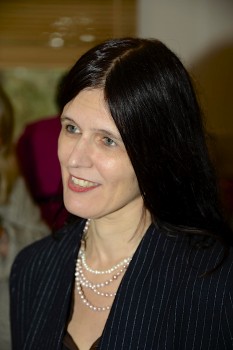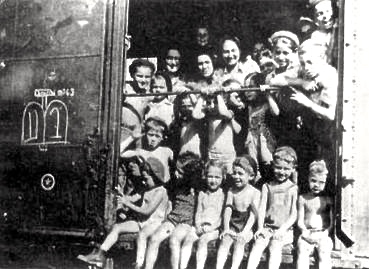“The sidewalk was cleansed of the blood. Rivers of rain, water hoses, and street sweepers joined forces to scrub the surface after the last remnant was removed. Submissive, the street continued to absorb convoys of people, scraps of paper and cigarette butts…Who could remember that stormy night, thirty years ago, when a woman jumped to her death from her rooftop apartment in one of the few still-intact buildings? Of sound mind, with the same parsimonious strictness she used to do everything…the teacher took her life.”
Elsa W eiss, a teacher who had arrived in Tel Aviv as a refugee from the Holocaust years ago, was a mystery to all her students, and when she jumped from the top of a building and committed suicide in 1982, she deliberately “left no testimony behind.” Only a single photograph served as a tangible reminder of her adult life, a rare passport photo which had traveled through successive editions of the high school yearbook, a “mirror of her life, [bearing] the pride and severity of someone who rarely talks to another soul.” An enigma throughout her career, she was about sixty when the narrator of this book knew her in class, a heavily made-up woman in gray clothes whose gaze conveyed the idea of “keep your distance,” the “war paint” of her appearance “heralding a latent battle in which she was trapped.” Her students, most of whom enjoyed her classes, “were her entire world, or most of it, sewn and unraveled anew each year,” young people who shared her life for a year and then were replaced. “She would not have us teach her anything, just as she spared us her own story.”
eiss, a teacher who had arrived in Tel Aviv as a refugee from the Holocaust years ago, was a mystery to all her students, and when she jumped from the top of a building and committed suicide in 1982, she deliberately “left no testimony behind.” Only a single photograph served as a tangible reminder of her adult life, a rare passport photo which had traveled through successive editions of the high school yearbook, a “mirror of her life, [bearing] the pride and severity of someone who rarely talks to another soul.” An enigma throughout her career, she was about sixty when the narrator of this book knew her in class, a heavily made-up woman in gray clothes whose gaze conveyed the idea of “keep your distance,” the “war paint” of her appearance “heralding a latent battle in which she was trapped.” Her students, most of whom enjoyed her classes, “were her entire world, or most of it, sewn and unraveled anew each year,” young people who shared her life for a year and then were replaced. “She would not have us teach her anything, just as she spared us her own story.”
Focusing on Elsa Weiss and her life, Israeli author Michal Ben-Naftali develops the narrative into a stunning novel about aspects of the Holocaust and its effects on its victims, unlike any other that I have read in my many years of reviewing. This novel has surprises on every page, differing from most other “Holocaust novels” in that it does not follow the customary pattern of presenting innocent victims, the horrors they face from the Nazis, their crises, and the new lives some develop in the aftermath of the war. Instead, author Michal Ben-Naftali presents in Elsa Weiss a woman who has hidden her personal details and personality throughout the Holocaust and even afterward, a woman who has become virtually anonymous. Her life feels almost peripheral to the horrors of the 1940s, and she survives the wartime savagery in part because she blends in, at least in the opinion of one of her former students.

While teaching in Tel Aviv, Elsa accompanies students on a trip to Shavei Tzion, a Byzantine ruin in the north of Israel. Photo by Shmuel Bar-Am.
This unnamed student herself is also now a literature teacher in Tel Aviv, where she and Elsa both lived, but she is a very different kind of teacher from Elsa. She wants her students to call her by her first name and tries to connect on a personal level with them. No matter how much experience she gains, however, she admits that she herself is still searching for a special someone, the teacher who can teach her “the lesson that only a few could teach, or that only one in particular could teach,” Elsa Weiss. Knowing little about her, the unnamed teacher must rely on what “might have happened, and most likely did happen to the one who went to the point of no return.” The only real facts this teacher has are that Elsa was born in 1917, passed away in 1982, parted from her parents in 1944, and that she crossed oceans and continents. “I know everything and nothing at all…From this point forward, it is all fiction.”
And so the invented story of Elsa’s life begins. Born in Hungary, Elsa is said to have lived in pre-war Paris, where she studied French and then taught it. Through flashbacks and flash-forwards, the narrator-speaker also invents Elsa’s early life in Hungary and her family and friends there, establishing the religious rivalries within Judaism and some of the tensions between Gentiles and Jews. After high school, Elsa travels to Paris, marries in 1939, then returns with her husband to Hungary. The family’s safety collapses in March, 1944, with the German invasion of Kolozsvar, where they lived, though “most Hungarians in Kolozsvar [were] indifferent to what [was] happening around them,” even with the Nazis’ establishment of a ghetto of almost twenty thousand inhabitants. Though Elsa believes that negotiating with the Germans is the best way to solve their difficulties, her parents eventually convince her to take the parents’ own tickets on the “Kastner train” to Palestine, and she obeys, eventually landing, however, at Bergen-Belsen, where she experiences some of the punishments and torments meted out to all Jews. Later, she arrives by delayed Kastner train in Switzerland, where she becomes a resident of a sanatorium in the resort town of Caux, from which she finally leaves for Palestine.

Rudolph Kastner who saved 1600 people on one of his trains but faced trial for the way he achieved this.
What makes this novel so different from others describing this period is that, throughout, Elsa manages to avoid the biggest horrors of the Holocaust, always believing that things are not as bad as people think they are. Intelligent and hard-working, her post-war awakening to the realities of the Holocaust, and, by contrast, the realities of her own survival, leave her with a sense of guilt beyond measure as she examines her own life and her decisions during the war – her belief in appeasement in Hungary, her disregard of the seriousness of the Nazi movement, her acceptance of tickets on the Kastner Train, and eventually her fortuitous immigration to Israel and its new beginning. In 1953, when Rudolf Kastner himself is put on trial for his connections to Adolf Eichmann and payoffs by the wealthy to get them to Switzerland, Elsa realizes, with dismay, the full truth of what she has done, a realization for which she spends the rest of her life atoning as a “tarnished victim.”
Dramatic and thought-provoking, this novel abandons the traditional visions of Holocaust survivors and their stories, presenting Elsa Weiss in a series of seemingly hopeless situations from which she believes she can escape, and does. The aftereffects of her survival on her values and sense of identity, however, show her spending the remainder of her life trying, on some level, to erase her naive decisions and allow her to atone for her mistakes. The eventual visit of the teacher-narrator to Elsa’s grave and her discoveries there, reveal the ultimate lesson of this superb novel.
Photos. The author’s photo appears on http://institutfrancais-israel.com
While teaching in Tel Aviv, Elsa accompanies students on a trip to Shavei Tzion, a Byzantine ruin in the north of Israel. Photo by Shmuel Bar-Am. https://www.timesofisrael.com/
Families on a “Kastner train” to Israel: https://en.wikipedia.org/
Rudolf Kastner (1906 – 1957) saved 1600 lives by paying Adolf Eichman to let them pass. He was tried after the war and shot to death by a murderer. https://en.wikipedia.org/wiki/Kastner_train Full story on Wiki, here.
Caux, Switzerland, where Elsa Weiss spent time in a sanatarium, formerly a hotel, recovering from the horrors of the Holocaust as it affected her family. https://english.vietnamnet.vn



